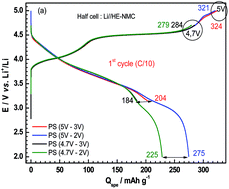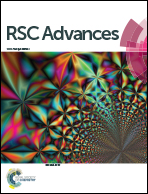Role of propane sultone as an additive to improve the performance of a lithium-rich cathode material at a high potential
Abstract
This study presents the use of 1,3-propane sultone (PS) in the [EC–DMC + 1 mol L−1 LiPF6] electrolyte as a protective additive for the Li-rich-NMC xLi2MnO3–(1 − x)LiMO2 (x ≫ 1; M = Ni, Co, Mn) cathode–electrolyte interface during cathode material activation and cycling at a high potential (5 V vs. Li). The results showed that the presence of 1% PS (w/w) ensured complete and better electrode activation during the first cycle than EC–DMC + 1 mol L−1 LiPF6. Thus, Li//Li-rich-NMC half-cell and Gr//Li-rich-NMC full-cell provided capacities as high as C = 330 mA h g−1 during charge and C = 275 mA h g−1 during discharge with a higher cut-off voltage of 5 V. Measurements by cyclic voltammetry demonstrated that activating at such a voltage enhanced the redox activity from Li2MnO3 activation. At same time, the contribution of nickel and cobalt electroactivity is decreased at their regular voltage. This feature was attributed to structural modifications occurring on the surface to the bulk of the material. Long-cycling tests of Li//Li-rich-NMC half-cells with PS provided a higher reversible capacity and superior capacity retention (245 mA h g−1 after 240 cycles) with good coulombic efficiency (99 ± 1%) and better high-discharge rate capability (above 180 mA h g−1 at 1 C regime) than those obtained using conventional electrolytes without additive.


 Please wait while we load your content...
Please wait while we load your content...